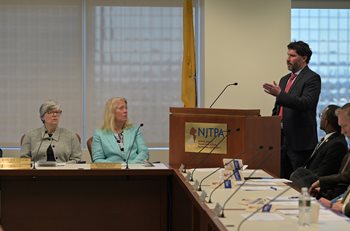Metropolitan Planning Organizations (MPOs) like the NJTPA across the U.S. are striving to help local governments take advantage of historic funding available for infrastructure and transportation, which is bringing once-in-a-generation opportunities in the coming years.

Bill Keyrouze,
executive director of the
Association of Metropolitan Planning Organizations (AMPO), provided an overview of these increased resources available through the Infrastructure Investment and Jobs Act (IIJA) as well as the challenges associated with them, in a presentation at the May 8 meeting of the NJTPA Board. A video of the presentation is
here.
Despite significant funding available through IIJA, many local governments face challenges in developing applications due to staffing shortages and lack of matching funding, according to Keyrouze.
“We know that’s a struggle across the country. It’s a lot to navigate and understand if you have a project,” Keyrouze said. Moreover, preparing an application has no guaranteed return on investment since most grant programs are competitive. AMPO, he said, is “constantly working with the U.S. Department of Transportation (USDOT) on guidance and trying to understand how to better implement all this.”
He said that new federal technical assistance programs, such as the Thriving Communities program, are available to assist with application development. In addition, new federal tools, such as the Discretionary Grants Dashboard, help identify appropriate grant opportunities. The NJTPA, for its part, has been providing consultation, technical assistance and letters of support for applications.
“Our message is that a rising tide raises all ships,” Keyrouze said. “If we collectively -- at the local, regional or state level -- can all work better together, then we all win at the end of the day. It’s about the services that we’re providing and delivering.”

Keyrouze said New Jersey is doing “very well” compared to other states in receiving IIJA funding. Thus far, he said the state has received $5.5 billion in both discretionary and formula funding, underwriting 92 projects. Over the five-year life of IIJA, discretionary funding totals $28 billion of the $100-billion provided by the law – up from $5.5 billion in the previous federal transportation funding law.
New guidelines written into the bill also encourage MPOs to work more closely with housing agencies. The Arlington, Va.-based AMPO has been coordinating with USDOT and Department of Housing and Urban Development (HUD) to identify best practices to better coordinate transportation, land use and housing policies.
Keyrouze shared a recent example of the often unappreciated impacts of transportation grants. School buses in a suburban Atlanta school district were outfitted with sensors to pre-empt red traffic lights along their route, speeding their trips. An unexpected benefit was that drivers saw fewer student disruptions, which often occurred when stopped at red lights. In addition, all students arrived in time to take advantage of free breakfast provided at school, which some previously missed due to delays.
“Sometimes it’s nice to step back and think about the impact that we can have as transportation planners and local elected officials. We often get caught up in the day to day and lose sight of the bigger picture,” Keyrouze said.
“Our work doesn’t have to be complicated to be consequential,” NJTPA Chair John Bartlett agreed.